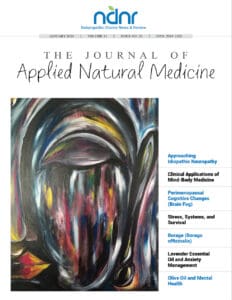Eric Yarnell, ND, RH(AHG)
These three medicinal trees all contain significant quantities of salicylates, on the order of 3%-10% by dry weight in bark and leaves. Many ancient texts, including the Ebers papyrus (approximately 5,100 years old), recommend these and related herbs for rheumatic symptoms. This ancient wisdom has been confirmed repeatedly in modern research.
Aspirin was synthesized from salicylic acid by Felix Hoffmann, then working at Bayer in Germany, and it was ultimately marketed for the first time in 1899. Unfortunately, more than 100,000 people in the U.S. alone each year are hospitalized due to ulcers (perforated or otherwise) or bleeding due to aspirin or non-steroidal anti-inflammatory drugs, and more than 15,000 of them die (Fries, 1996). Thus, natural alternatives to aspirin and NSAIDs remain a crucial necessity in helping patients deal with pain and inflammation.
Willow
Salix spp (willow) bark was first systematically proven effective by the revered Edward Stone in Oxfordshire, England, for relieving fever (Stone, 1763). He used 1.8g doses of the bark, and most of his patients probably had malaria. Willow has historically been used for all manner of conditions characterized by pain and inflammation, particularly affecting the musculoskeletal system as well as suppressing excessive fevers. There are an enormous number of species in the genus and various ones occur in many parts of the globe. This has led to widespread and relatively homogenous use of the valuable resource. Though Salix alba (white willow) from northern Europe is often listed as the willow of choice, there is essentially no firm basis for this. It has not been shown to have higher levels of constituents or to be more effective than other species in head-to-head comparisons. In my experience, it tends to be significantly weaker than local species, possibly due to the fact that S. alba is dried and stored for long periods before reaching end users in the U.S.
Clinical trials have been conducted on willow bark extracts for a variety of musculoskeletal conditions, primarily chronic low back pain (CLBP) and arthritis. In a double-blind trial of willow for CLBP, 210 patients were randomly assigned to placebo or willow standardized extract delivering 120mg or 240mg salicoside per day (Chrubasik et al., 2000). Both doses of willow were significantly superior to placebo at relieving pain and reducing need for tramadol rescue medication after four weeks. An open trial has shown that using willow extracts is more cost- effective than standard orthopedic practice for patients with CLBP (Chrubasik et al., 2001a). In a comparative open trial, willow bark standardized extract delivering 240mg salicoside daily has been shown as effective as rofecoxib (Vioxx) 12.5mg daily for relieving CLBP in 114 patients (Chrubasik et al., 2001b).
The most rigorous double-blind trial to date evaluated the effect of a standardized willow bark extract delivering 240mg salicoside per day compared to diclofenac 100mg per day and placebo in 127 patients with hip or knee osteoarthritis (Biegert et al., 2004). No difference between placebo and this willow extract at this dose was noted after six weeks. Diclofenac was significantly superior to the willow extract. In a smaller double-blind trial published at the same time, the same dose of willow extract was not more effective than placebo in patients with active rheumatoid arthritis (n=26). These results suggest that willow should either be used in other forms, higher doses or combined with other therapies if they are going to be effective in patients with more severe conditions.
In one double-blind trial (Hyson, 1998), topical salicoside has been shown to be significantly more effective at relieving tension headaches with photophobia than placebo.
Recommended doses of crude bark are 2-5g tid for chronic problems, up to 5g four to five times per day for acute problems. Doses of tincture (1:2-1:3) are 3-5ml tid for chronic problems, up to 5 times per day for acutes.
Willow Salicylates
Willow contains the glycoside salicoside (often called salicin), which is metabolized in the body to salicylic acid, widely reported to be the “magic bullet” that accounts for the antipyretic, inflammation modulating and analgesic effects of willow. However, intake of willow bark extracts standardized to 240mg salicoside per dose were found to lead to serum levels of salicylic acid consistent with intake of 87mg of aspirin (Schmid et al., 2001). This makes it unlikely that salicoside by itself is the active constituent in this herb.
There is some evidence from in-vitro research that the activity of willow bark cannot be explained by salicylic acid alone. One study found that ethanolic extracts of willow bark had a mild inhibitory effect on production of pro-inflammatory cytokines, such as tumor necrosis factor-alpha and interleukin-1beta, as well as slightly inhibiting production of prostaglandin E2 (Fiebich and Churbasik, 2004). However, pure salicin and salicylic acid had no effects in this system.
Aspen and Birch
Populus tremuloides (aspen) is in the same Salicaceae family with willow and contains very similar compounds. It has a greater historical use in lung conditions, particularly related species often referred to as balm of Gilead (Populus candicans, P. trichocarpa and others) in which the resinous buds are used. Aspen bark can be used interchangeably with willow. Aspen has not been the subject of any clinical trials on its own, though combined with Solidago virgaurea (goldenrod) and Fraxinus excelsior (ash), it has been shown to have inflammation modulating effects (el-Ghazaly et al., 1992).
Betula spp (birch) bark, though in the separate Betulaceae family, has similar salicylate constituents to willow and aspen, and can also be used interchangeably with these two. It is historically considered to have more of an affinity with the genitourinary tract. As an aside, birch is a source of betulinic acid, which has received much attention as a potential antineoplastic compound. An open clinical trial recently confirmed that birch bark ointment was very effective at curing actinic keratoses in 28 patients (Huyke et al., 2006).
Willow, aspen and birch should generally be combined with other therapies, as they do not tend to address underlying causes of disease. The one exception to this is when chronic inflammation has become self-sustaining, in which case they can help break the inflammatory downward spiral.
Safety
Salicylates in these trees can cause allergic reactions in people who are sensitive to aspirin. Therefore, anyone with asthma, nasal polyps or known salicylate sensitivity should avoid these and any other significant sources of salicylates.
The salicylates found in each of these trees do not have any clinically significant effect on platelet aggregation (Krivoy et al., 2001). Thus, there is no reason to avoid combining them with aspirin or anticoagulant medications out of concern for increased risk of bleeding. They also cannot be substituted for aspirin in reducing the risk of atherosclerotic complications as far as is known.
There is no information available about natural salicylates and Reye’s syndrome, but for the sake of greatest safety, they should be avoided in children with influenza until more information is available.
Willow, aspen and birch have not been demonstrated to cause peptic ulcer or gastrointestinal bleeding at usual therapeutic doses. However, they can cause nausea, which is usually easily remedied by taking them with food.
References
Biegert C et al: Efficacy and safety of willow bark extract in the treatment of osteoarthritis and rheumatoid arthritis: results of 2 randomized double-blind controlled trials, J Rheumatol 31(11):2121-30, 2004.
Chrubasik S et al: Treatment of low back pain exacerbations with willow bark extract: a randomized, double-blind study, Am J Med 109:9-14, 2000.
Chrubasik S et al: Treatment of low back pain with a herbal or synthetic anti-rheumatic: a randomized controlled study. Willow bark extract for low back pain, Rheumatology (Oxford) 40(12):1388-93, 2001a.
Chrubasik S et al: Potential economic impact of using a proprietary willow bark extract in outpatient treatment of low back pain: an open non-randomized study, Phytomedicine 8(4):241-51, 2001b.
el-Ghazaly M et al: Study of the anti-inflammatory activity of Populus tremula, Solidago virgaurea and Fraxinus excelsior, Arzneim Forsch 42:333-6, 1992.
Fiebich BL, Chrubasik S: Effects of an ethanolic Salix extract on the release of selected inflammatory mediators in vitro, Phytomedicine 11(2-3):135-8, 2004.
Fries J: Toward an understanding of NSAID-related adverse events: the contribution of longitudinal data, Scan J Rheumatol 25(suppl 102):3-8, 1996.
Huyke C et al: Treatment of actinic keratoses with birch bark extract: a pilot study, J Dtsch Dermatol Ges 4(2):132-6 [in German], 2006.
Hyson MI: Anticephalgic photoprotective premedicated mask. A report of a successful double-blind placebo-controlled study of a new treatment for headaches with associated frontalis pain and photophobia, Headache 38(6):475-7, 1998.
Krivoy N et al: Effect of salicis cortex extract on human platelet aggregation, Planta Med 67:209-12, 2001.
Schmid B et al: Pharmacokinetics of salicin after oral administration of a standardized willow bark extract, Eur J Clin Pharmacol 57(5):387-91, 2001.
Stone E: An account of the success of the bark of the willow in the cure of agues, Philadelphia Transactions of the Royal Society 53:195-200, 1763.

Eric Yarnell, ND, RH(AHG) is a graduate of Bastyr University. He completed a two-year residency with Silena Heron, ND, and served as chair of botanical medicine at the Southwest College of Naturopathic Medicine. He is past senior editor of the Journal of Naturopathic Medicine. Dr. Yarnell is a founding member and current president of the Botanical Medicine Academy and author of numerous textbooks and articles, including Naturopathic Urology and Men’s Health, Naturopathic Gastroenterology and Clinical Botanical Medicine. His area of clinical focus is urology and men’s health. He is assistant professor in botanical medicine at Bastyr University.

